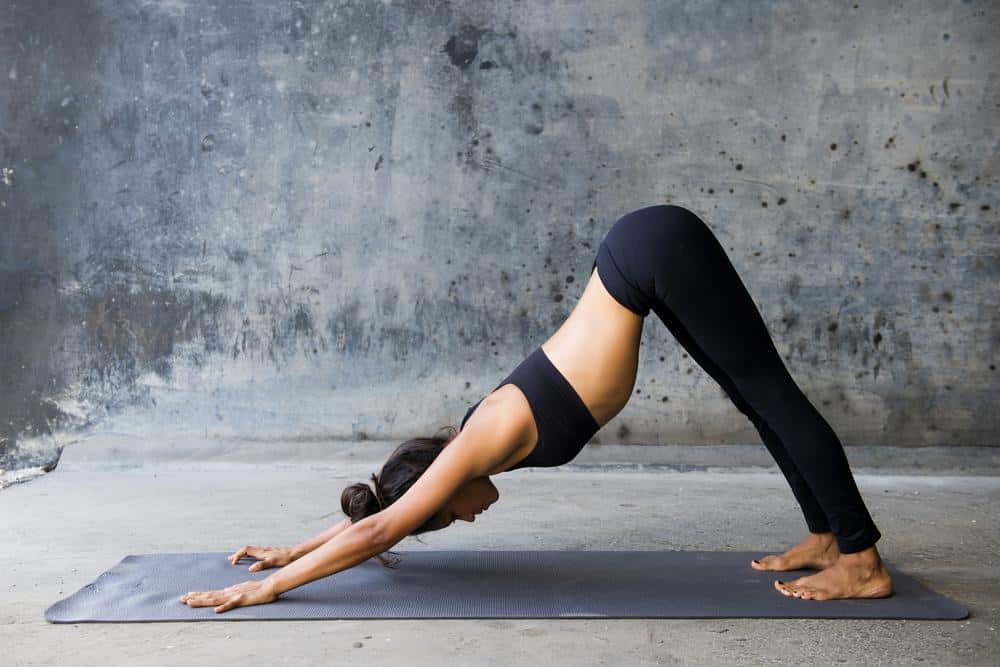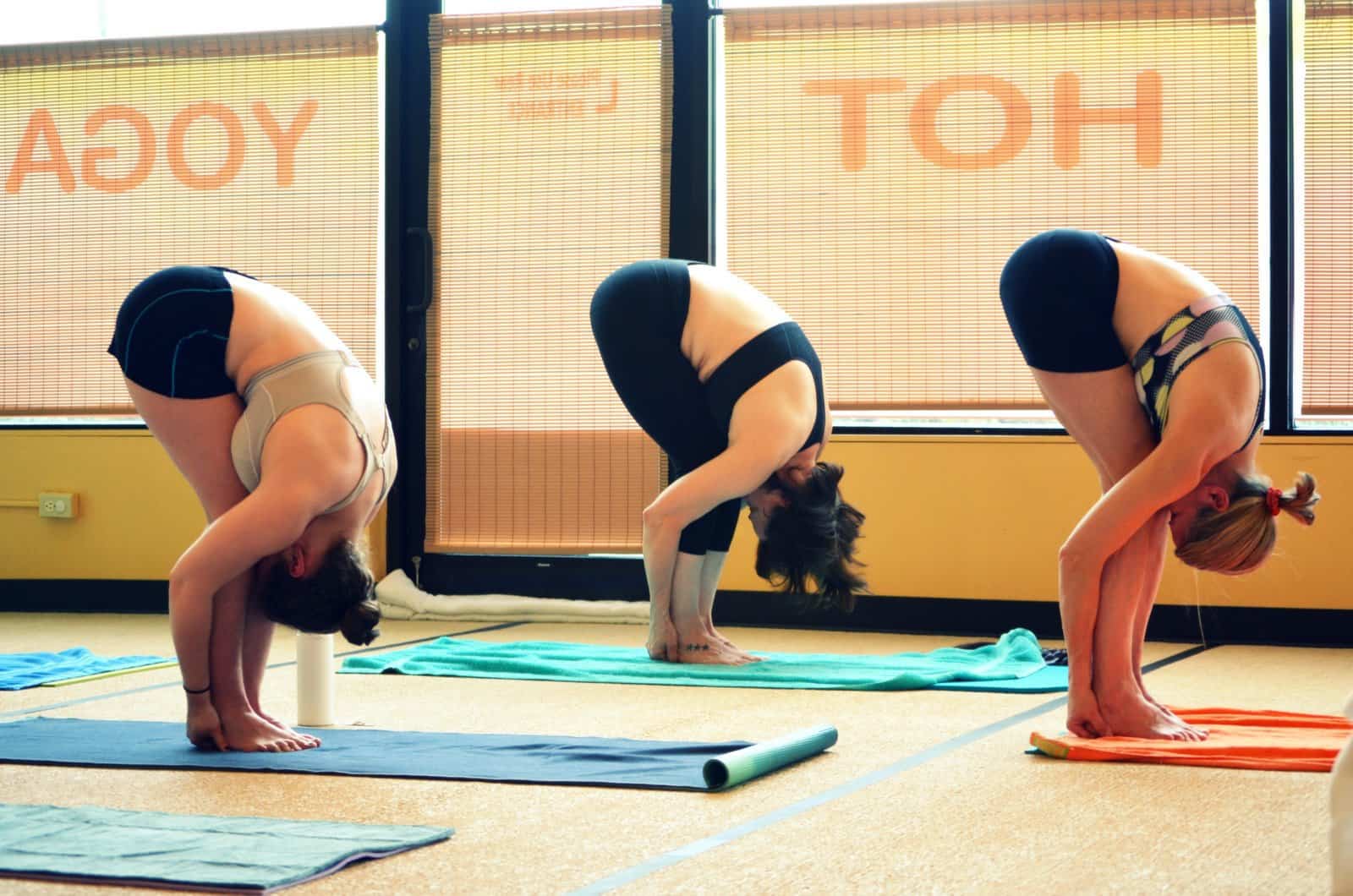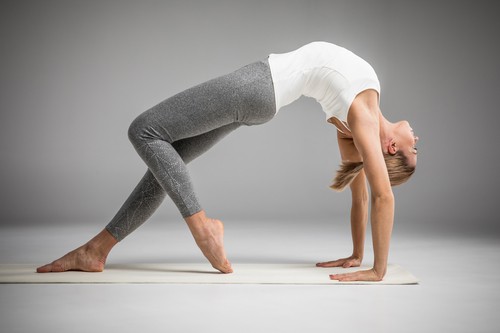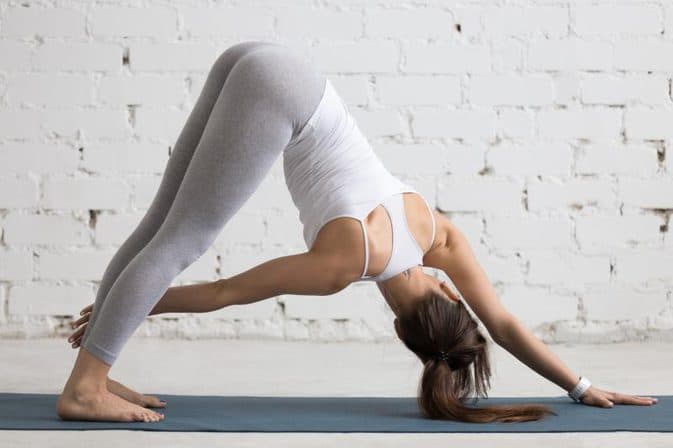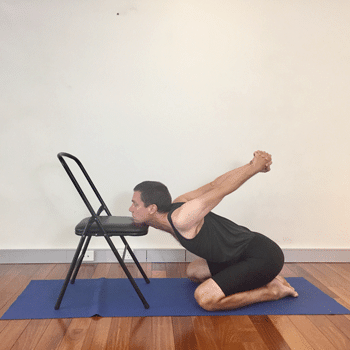But as we age, not all exercises offer the same benefits. High impact training like weightlifting and running can hurt our joints. The challenge then becomes to find an activity that we enjoy and that can improve our overall health, with minimal risk. Yoga offers just such an opportunity. More and more research has shown that yoga is an excellent total body exercise for your body and your mind. In this article, I’m going to quickly show you the yoga benefits, whether you’re in your 40’s, 50’s, 60’s, 70’s or 80’s. Then we’re going to show you how you can get started quickly and easily.
Amazing yoga benefits for men and women over 40
Here I’ll cover 6 benefits of practicing yoga:
1. Yoga improves strength
You don’t often associate Yoga with strength training. But you don’t have to look like a Mr. Olympia, nor do you have to train like one, to get the benefits of strength training. Yoga uses many weight bearing exercises[1] like the plank, eagle (single legged squat) and the warrior pose which can create a burn with the best of them and improve muscles in your legs, core and shoulders for a great, low impact, total body workout. In fact, two of the five best exercises recommended for strength and balance are yoga poses![2]
2. Yoga increases flexibility
As we age, our muscles and joints get tighter and less flexible. We don’t need a scientific study to prove it. Just trying to tie our show laces, scratch our back or put on our socks is research enough. Yoga offers a series of stretches for our legs, hips, shoulders, hands and back that have proven to improve muscle flexibility and joint range of movement. In fact, yoga has even been shown to reduce the pain associated with osteoarthritis.[3]
3. Yoga benefits balance
Whether it’s biking, gardening or hiking, maintaining balance is critical to being able to continue doing the activities we loved to do safely well into our adult life. It also helps us avoid dangerous falls. Try a one legged tree pose, or a headstand and you’ll get a sense for how good yoga is for your balance.
4. Yoga is good for your heart
Studies show that yoga can possibly lower your heart rate, eases palpitations, improves symptoms of heart failure, improves blood pressure and lowers hypertension when you combine postures, breathing and meditation in your yoga practice.[4] Yoga is shown to have similar benefits as brisk walking or other similar cardio exercises.
5. Yoga is good for your bones
People in their 50’s and beyond face the challenge of lower bone density, which could, if left unchallenged lead to osteoporosis. The weight bearing nature of yoga exercise has consistently proven to benefit bone density and reduce the risk of osteoporosis in those over 50 years old – especially women. In fact, one study showed that doing just 12 minutes of yoga a day can reverse osteoporotic bone loss.[5]
6. Yoga reduces anxiety and sharpens the mind
Yoga was traditionally done as a preparatory exercise for meditation. It’s emphasis on breathing and focus on the task at hand have been proven to have benefits for the mind.[6] Yoga has been shown to reduce stress, anxiety, depression, improve sleep, and enhance overall well-being. Give savasana a try and you’ll instantly see what I’m talking about:
How to get started
Starting yoga is easy! Nearly 10% of Americans, of all ages, currently do yoga, so you’re not alone. I’d recommend you start out by taking a beginners yoga class with a qualified instructor. This will give you the opportunity to learn how to do each yoga pose with proper form, which is essential to get the maximum benefit from each pose and to avoid injury. You should also take a yoga class that includes the full gamut of techniques like poses, breathing and meditation. Doing so will ensure that you maximize the physical, cardiovascular and mental benefits of yoga. If you have any preexisting conditions like a sore back, arthritis, torn rotator cuff, ACL or MCL sprains etc, it’s important to tell your instructor in advance. A good instructor will be able to amend poses for you to avoid unnecessary or dangerous strain to affected areas that might aggravate your injury.
Where to do yoga
Yoga classes are available almost everywhere, from your local health clubs and gyms to YMCA’s, community and senior centers. You can also find stand alone yoga studio’s. Sessions cost anywhere from $15-$20 at yoga studios. You might want to buy individual sessions at first to see if you like your instructor before committing to multiple sessions to get a volume discount. If you’d prefer to be in a private setting, you can also get a private instructor to come to your house.
What type of yoga is best for you?
There are several types of yoga to choose from. We’d definitely recommend you do a yoga practice that includes poses, breathing and meditation, as opposed to a fitness session that includes some yoga poses. Hatha Yoga
Best for beginners because of slow pace and introduction to basic techniques. Hatha yoga simply refers to all styles of yoga that are grounded in physical practice. A Hatha class generally teaches the basic physical poses. Hatha yoga classes are good if you’re starting out because they offer a classic approach to breathing and poses and typically go at a slower pace than some of the other styles. If a class calls itself hatha, it’s generally intended for beginners.[7] Bikram Yoga
Best for beginners, people who want a sweat or those who like a set routine because of Bikram’s predictable routine. Bikram yoga is hot! The yoga studio is set to 105 degrees with 40 percent humidity. Invented by Bikram Choudhury about 30 years ago, Bikram yoga includes a series of 26 poses, with each one done twice per session. The heat is supposed to increase flexibility and suppleness. Bikram is one of the most popular types of yoga around, so its pretty easy to find. Just make sure you can stand the heat and stay hydrated! Ashtanga Yoga
Best for those looking for a more rigorous workout and a predictable routine and sequence of exercises. Ashtanga is rooted on ancient yoga. It’s a more defined and difficult style of yoga that has a set sequences of poses, where each movement is tied to a breath.[8] Ashtanga always performs the same poses, in the exact same sequence. It was popularized in the West by K. Pattabhi Jois in the 1970’s. Vinyasa Yoga
Best for those looking for a high intensity workout because of its faster pace, of flowing from one movement into another. Vinyasa is a very fluid style of yoga, and probably the most athletic.[9] A variation of Ashtanga, Vinyasa coordinates movement with breath and you typically flow from one movement into the next, not staying n one pose for very long. It’s different from Ashtanga, in that there is no set sequence of movements. Iyengar Yoga
Best for those with injuries and those obsessed with form and getting their poses right. Iyengar yoga is not afraid to use props, blocks, straps, walls and blankets to help you hit the perfect form with precision detail. The biggest difference between Iyengar and Vinyasa is that while there is no set sequence, each pose is held for a set period of time.[10]
Yoga equipment
One of the great things about yoga is that you actually don’t need any equipment or special clothing. All you need are clothes that are either loose fitting or stretchy enough to allow you to do any of the poses without restriction. You may want a mat of your own eventually, but if you’re just getting started, often times studios provide one for you. Straps and pillows, if used, are also typically provided by studios.
Yoga frequency
If you’re just starting out, some yoga instructors suggest doing it everyday for 10-25 minutes, so that you can start to train your muscle memory for each yoga pose. That might mean you got to 1-2 classes per week, to make sure your getting good instruction on how to perform each pose properly, but then doing 10-25 minutes a day at home when you’re not going to the yoga class. As referenced earlier in this article, one study showed that doing just 12 minutes of yoga a day can reverse the effects of bone density loss. Then again, many instructors will tell you that doing just 1 class a week will have benefits to your health and state of mind.
Summing it up
Yoga is one of the fastest growing activities in the United States, with people of all ages enjoying its benefits to the health of your body and mind. A relatively low impact exercise, regularly practicing yoga, even for short periods of time, will improve your strength, balance, flexibility, cardiovascular health and your mind. With so much to gain and so little to lose, give it a try and see how it makes you feel! Featured photo credit: Pexels via pexels.com
